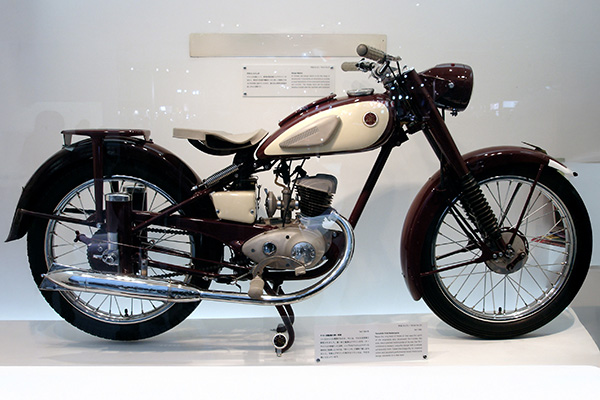Yamaha Motorcycles – 1955 (70 years)
Few manufacturers have shaped the motorcycle world quite like Yamaha. From its humble beginnings in post-war Japan to the global powerhouse it is today, Yamaha has spent seven decades combining technical ingenuity with an unmistakable sense of soul.
This year, the brand celebrates 70 years of motorcycle production, marking a milestone for one of the most enduring and influential names in two-wheeled history.
From pianos to pistons

Yamaha’s story begins not on two wheels, but in music. The company traces its roots to Nippon Gakki, a musical instrument maker founded by Torakusu Yamaha in 1887. Known for pianos, organs, and precision craftsmanship, it wasn’t until after World War II that the company diversified.
In the 1950s, Japan was rebuilding. Factories once used for aircraft propellers and metal machining looked for new purposes. At the time, there was enormous demand for affordable personal transport - small, efficient motorcycles that could get people to work.
Recognising this opportunity, Genichi Kawakami, Yamaha’s then-president, decided to transform the company’s technical expertise into mobility. In 1953, he repurposed a section of the factory in Hamakita to begin motorcycle production. The following year, Yamaha’s first bike rolled off the line: the YA-1, a 125cc, two-stroke, single-cylinder machine inspired by European design.
Nicknamed the Red Dragonfly, the YA-1 was light, nimble, and beautifully engineered. It made an immediate impression, not only for its reliability but for its performance in racing. In its debut year, it won Japan’s prestigious Mount Fuji Ascent Race and the Asama Highlands Race, setting the tone for Yamaha’s future philosophy: build motorcycles that perform and win.
Yamaha’s early success quickly translated into global ambition. In 1958, it began exporting motorcycles to the States, a bold move that would establish its reputation as one of Japan’s ‘Big Four’ manufacturers alongside Honda, Suzuki, and Kawasaki.
By the 1960s, Yamaha had embraced innovation with open arms. The YDS series, particularly the YDS-3, featured cutting-edge oil injection technology (Autolube), eliminating the need for riders to pre-mix fuel and oil - a genuine game-changer at the time.
The 1970s saw Yamaha go from strength to strength. The RD range - short for “Race Developed” - became legendary among riders who wanted serious performance at an attainable price. The RD250 and RD350 offered two-stroke thrills that could embarrass much larger bikes. Today, they remain cult classics, celebrated for their razor-sharp handling and raw, unfiltered character.
And then came 1973: the TZ750, Yamaha’s fire-breathing two-stroke racer, a bike so fast that even seasoned riders found it terrifying. Its dominance on the track cemented Yamaha’s reputation as a company that pushed boundaries, and it gave rise to racing heroes like Kenny Roberts, who helped deliver multiple world championships for the brand.
And who can forget the FS1-E – a 49cc motorbike/moped that became a go-to for 16-year-olds who wanted freedom and thrills? Referred to as the ‘Fizzy’ it could achieve 50mph and amazingly, it looked like a proper motorbike. The ‘Fiz’ though was a bit of headache in terms of road safety: 16-year-olds with little road experience and a desire for speed was not a good combination and eventually the FS1-E had to be restricted to 30mph.
By the 1980s, environmental regulations began to squeeze out two-strokes, and Yamaha pivoted once again. The company introduced innovative four-stroke models like the XS1100, its first inline-four, and the FJ1100, which laid the groundwork for modern superbikes.
In 1985, Yamaha changed the sportsbike world forever with the YZF750 Genesis. Its five-valve-per-cylinder engine and aluminium frame were decades ahead of their time. A decade later, the 1998 YZF-R1 redefined what a litre-class motorcycle could be - light, aggressive, and devastatingly fast.

But Yamaha wasn’t only about performance. It diversified into off-road and adventure bikes, with models like the XT500, which won the inaugural Paris-Dakar Rally in 1979, and later the Tenere series, which remains one of the best-known adventure bikes in the world today.
Even Yamaha’s cruisers, like the Virago and XV series, proved that the brand could combine Japanese engineering with American-style touring comfort.
If there’s one arena where Yamaha has consistently excelled, it’s racing. From the early 1960s to today, Yamaha has competed - and won - in almost every motorcycle discipline.
In MotoGP, the brand’s YZR-M1 has become a benchmark, delivering multiple world championships under riders like Valentino Rossi, Jorge Lorenzo, and Fabio Quartararo. The combination of agility, power delivery, and precise handling echoes the brand’s founding principles - a racing DNA that flows directly into its production bikes.
In the 21st century, Yamaha continues to innovate while respecting its heritage. The MT (Master of Torque) series has helped bring the brand to a new generation of riders, blending urban practicality with naked-sport aggression.
Meanwhile, models like the XSR900 celebrate Yamaha’s retro roots, combining nostalgic design cues with modern engineering - a balance that resonates perfectly with classic enthusiasts and new riders alike.
Like every manufacturer, Yamaha has faced challenges. The oil crises of the 1970s, the economic turbulence of the 1990s, and increased competition from Europe and Asia all tested the company’s resilience. Yet Yamaha’s commitment to quality, performance, and innovation has never wavered.
One of Yamaha’s greatest strengths is its ability to evolve without losing its identity. Whether building a high-performance superbike, an adventure-ready Tenere, or a learner-friendly 125, every Yamaha motorcycle feels purposeful - engineered with the same blend of precision and passion that defined the YA-1 seven decades ago.

COMMENT